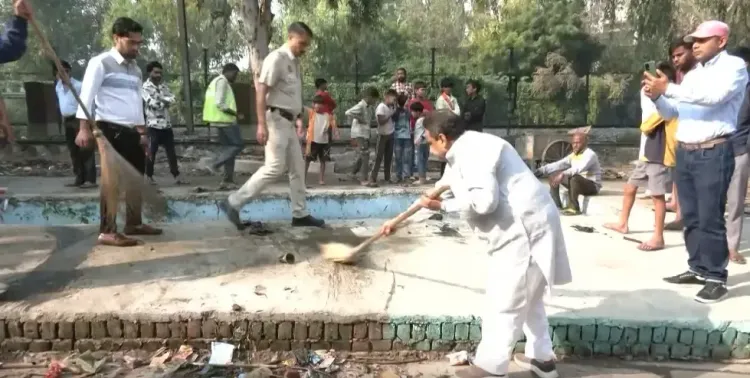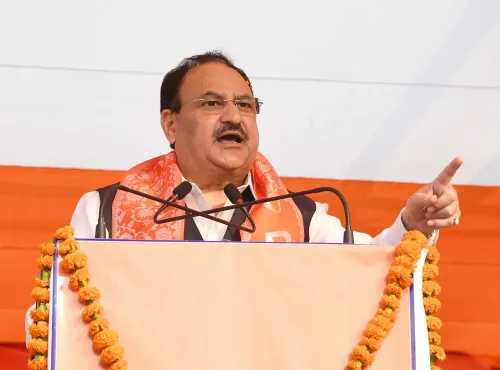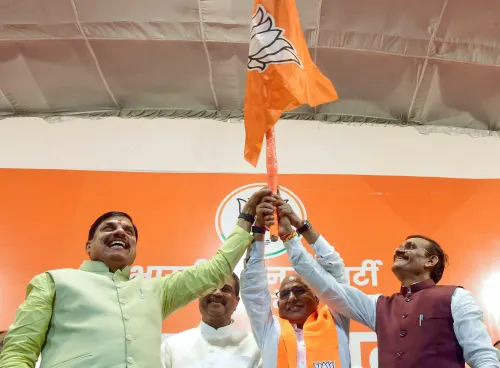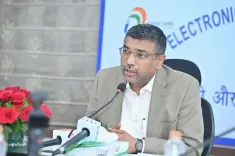Are 1,500–1,600 Ghats Ready for Chhath Puja in Delhi?

Synopsis
Key Takeaways
- 1,500 to 1,600 ghats are being constructed in Delhi for Chhath Puja.
- Chhath Puja emphasizes purity and gratitude.
- Devotees observe strict fasting during the festival.
- The festival includes elaborate rituals over four days.
- Community involvement is crucial for maintaining cleanliness.
New Delhi, Oct 23 (NationPress) BJP MP Praveen Khandelwal visited the Chhath Ghat located at the FCI Godowns near Nangia Park in Shakti Nagar on Thursday, where he took part in a cleanliness initiative. During his visit, he announced that approximately 1,500 to 1,600 ghats are being set up throughout Delhi for devotees to celebrate Chhath Puja this year.
In an interview with IANS, Praveen Khandelwal remarked, “Chhath Puja in Delhi is a significant festival that embodies devotion, purity, and gratitude. Cleanliness and sanctity are vital components of this celebration.”
He elaborated, “This year, under the guidance of Chief Minister Rekha Gupta, we are set to celebrate Chhath Puja on a grand scale. To this end, 1,500–1,600 ghats are being constructed and will be maintained for cleanliness. We personally inspected and cleaned the FCI Godowns Ghat, ensuring that cleanliness initiatives will persist throughout the year.”
Chhath Puja is one of the most important Hindu festivals, primarily celebrated in Bihar, Jharkhand, and eastern Uttar Pradesh. It is also observed in parts of Nepal and among Indian communities worldwide. This festival is dedicated to the worship of the Sun god and his sister Chhathi Maiya, highlighting themes of purity, gratitude, and family well-being.
Tracing its roots back to ancient periods of Satyuga and Dwapara Yuga, Chhath Puja is regarded as one of the oldest traditions of Sun worship. Devotees observe this festival with stringent discipline, refraining from food and drink for extended periods to convey their devotion and seek blessings for prosperity, health, and happiness. Worshipping Surya during Chhath is believed to eliminate negativity from life, thereby inviting peace and positivity.
The four-day festival involves intricate rituals that symbolize purification, faith, and self-control:
- Day 1 – Nahai Khai: Devotees begin by taking a holy dip in a river or pond to purify themselves. They bring clean ingredients into their homes and prepare initial offerings, underscoring cleanliness and sanctity.
- Day 2 – Kharna: On this day, devotees maintain a strict fast from sunrise to sunset. They prepare offerings of jaggery, rice, and wheat, breaking their fast in the evening after presenting offerings to the deity. The prasad is shared with family, friends, and neighbors to foster unity and community spirit.
- Day 3 – Sandhya Arghya: In the evening, devotees gather near water bodies to offer “arghya” (prayers and offerings) to the setting Sun. They present fruits, sugarcane, and prasad, expressing gratitude to the Sun god for sustaining life on Earth.
- Day 4 – Usha Arghya: The final day is reserved for prayers to the rising Sun. Devotees break their fast after making offerings, symbolizing renewal and spiritual rebirth. The prasad is distributed among family and community members, signifying the conclusion of the rituals.
Chhath Puja is celebrated with simplicity, dedication, and purity. Offerings, including fruits, vegetables, and sweets, represent nature's gifts, while the rituals of fasting and prayers signify the devotees' commitment to cleansing their body, mind, and soul. The essence of Chhath Puja revolves around gratitude, nurturing respect for natural resources and fostering a harmonious relationship between nature and humanity.









